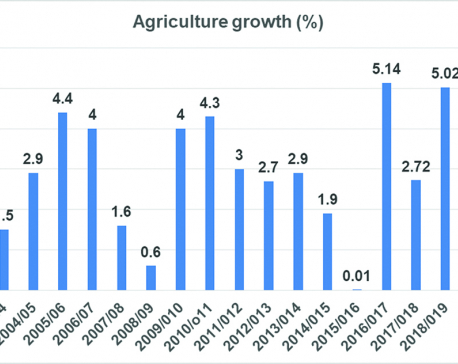
OR

We need to make agriculture governance system effective through the backup of strong organizational set-up and human resources
The new constitution has transformed Nepal into a federal country and devolved key functions, including that of agriculture, to seven provinces. Only a few functions are reserved exclusively for the federal government. Most functions, particularly those related to program implementation for agriculture and livestock development, are assigned to the provinces. However, scientific research is listed as a concurrent power of both provincial and federal governments. Local governments are given exclusive powers on farming and animal husbandry, agriculture marketing, livestock health, local roads, local irrigation projects, and management and control of agricultural extension. The agricultural governance has not been reformed in the light of these functional changes. But without the commitment to good governance in agriculture, production and productivity cannot be increased in a sustainable way. As Kofi Annan once said good governance is perhaps the single most important factor in eradicating poverty and promoting development.
According to the Agriculture Development Strategy (ADS), agricultural governance refers to the capacity of government to design, formulate and implement policies and discharge functions for agriculture development in the country. In the absence of such capacity the agricultural programs cannot be implemented successfully. There are good policies to support the agriculture sector in the country but the capacity of the government both in terms of organizational set-up and human resource at the local level is very weak. Thus agriculture sector will have to face many challenges in the days to come.
Challenging issues
Gaps in available human resource and needs at local sphere, overlapping of some of the responsibilities among federal, provincial and local levels, complicated coordination and increase in the financial burden are major challenging issues. In order to address these issues, we need to make agriculture governance system effective through the backup of strong organizational set-up and human resources. The government sector at all levels has to play key roles in coordinating the efforts of other actors, facilitating implementation of policies and plans, monitoring performance and enforcing regulations.
At present, both horizontal and vertical linkages have become very complicated. There is no mandatory coordination mechanism among federal, provincial and local level organizations. Mechanisms of horizontal coordination among provinces and among local governments are also lacking. Under the agricultural sector, which includes mainly agriculture, livestock, irrigation and land management, there are currently three federal ministries—Ministry of Agriculture and Livestock Development, Ministry of Land Management and Ministry of Irrigation. All these ministries are working almost in isolation. Their functional linkages are very weak. In order to strongly link them, the three ministries should be amalgamated. Likewise, as implementation of agricultural development program has been shifted to the provinces and local councils, all central departments should be downsized and adjusted accordingly.
Additional measures
All the provinces have the Ministry of Land Management, Agriculture and Cooperative responsible for agriculture development in their respective provinces. If irrigation is annexed to this ministry, it will be easier to implement programs in a coordinated way. In each province, there is Agriculture Development Directorate (ADD) under Ministry of Land Management, Agriculture and Cooperative. Similarly, 51 Agriculture Knowledge Centers (AKCs) are being established throughout the country and placed under the ADD. But these AKCs are not well equipped to perform the given functions. They need to be strengthened both in terms of physical facilities and human resources. Furthermore, the number of AKCs is also not adequate and 26 more AKCs have been proposed so that there will be one AKC in each district.
As in the past, the government agriculture farms are again kept in low profile. They are very much constrained with logistic supports. At present, these farms are managed haphazardly on personal interest of the farm manager. If these agriculture farms are strengthened to perform mandated functions, they will be helpful to increase production and productivity through better use of improved technologies. The trial and demonstration function of the AKC should be handed over to these farms and each farm should have its command areas for providing technical services. These farms may also be very effective practical schools for farmers where they can acquire practical knowledge by seeing and doing. The government of Nepal should look into these farms in this perspective and prioritize them in providing adequate budget and other resources for conducting training programs.
Nepal has six metropolitan cities, 11 sub-metropolitan cities, 276 municipalities and 460 rural municipalities (making 753 local governments in total). Responsibilities of agricultural extension services, local agricultural roads, small irrigation projects and livestock health services have been given to local governments. Considering these responsibilities, we may need one to three Community Agricultural Service Centers (CASCs) in each local government as proposed by the Agriculture Development Strategy (ADS). But the present arrangement is one gazetted second class officer with two supporting staffs in the Metro and Sub-metro city councils, one gazetted third class officer with one or two supporting staffs in municipalities and one junior technician (JT) and one junior technical assistant (JTA) in each village council. These arrangements cannot provide necessary services to the farmers.
Furthermore, the government should not have imposed a uniform organizational structure for each province. The provincial structure should be based on the need and potentiality of the province. For example, Nepal can avoid replicating agricultural training centers in each of the seven provinces. Instead they should be located only in those provinces where agro-ecological conditions are sufficiently distinct.
At present, the linkages between agricultural research, extension and education are also very weak or lacking. The ways forward to strengthening linkages among them could be (1) mandatory joint action plan (2) recognizing MOALD as the line ministry of Agriculture and Forestry University (AFU) and (3) developing agricultural alliances at provincial level. There is also a need of human resource development plan as subject-specific experts in some specific subjects such as biotechnology, climate change, processing and environment-controlled agriculture are in high demand.
bhairabr@gmail.com
You May Like This

Erratic pattern
Agriculture in Nepal is suffering from years of under-investment, limited research, scant inputs and lack of technology and services for... Read More...

Road to commercialization
If Nepal is to speed-up agricultural commercialization process for both import substitution and export promotion, there is no better way... Read More...

Commission of inaction
Two years after National Farmers’ Commission started to work, people are asking why we need such commission when it cannot... Read More...




Just In
- Rainbow tourism int'l conference kicks off
- Over 200,000 devotees throng Maha Kumbha Mela at Barahakshetra
- Indians vote in the first phase of the world’s largest election as Modi seeks a third term
- Kushal Dixit selected for London Marathon
- Nepal faces Hong Kong today for ACC Emerging Teams Asia Cup
- 286 new industries registered in Nepal in first nine months of current FY, attracting Rs 165 billion investment
- UML's National Convention Representatives Council meeting today
- Gandaki Province CM assigns ministerial portfolios to Hari Bahadur Chuman and Deepak Manange







_20220508065243.jpg)








Leave A Comment